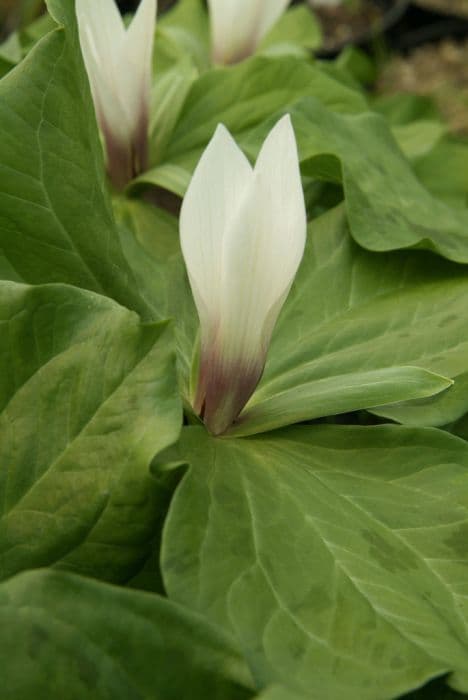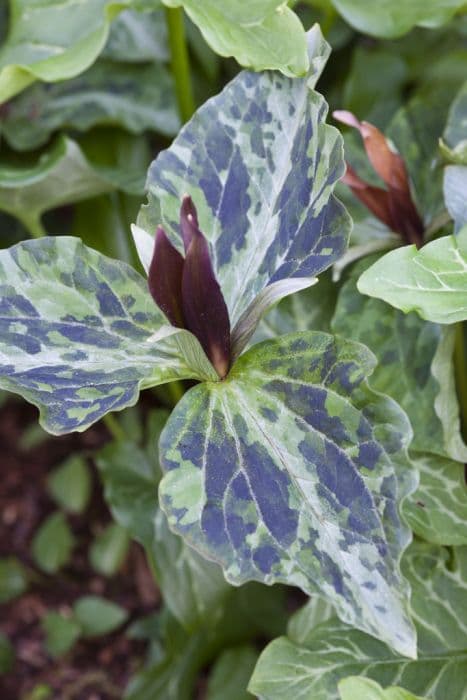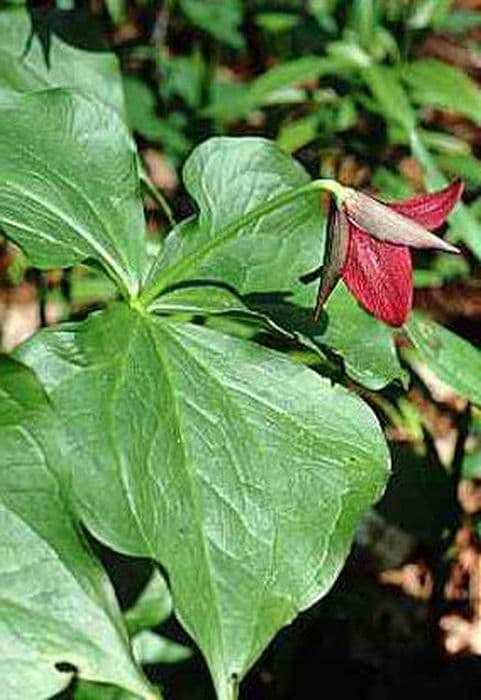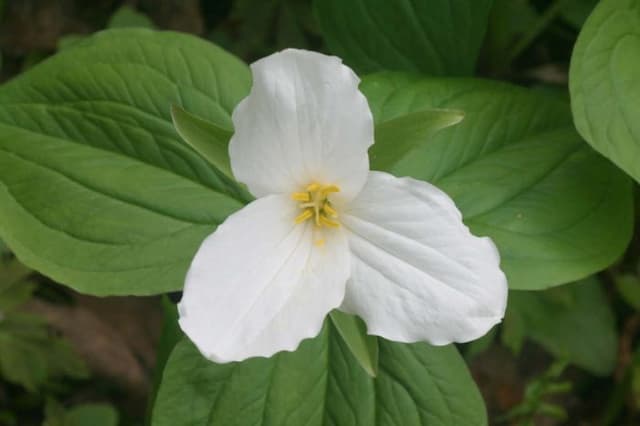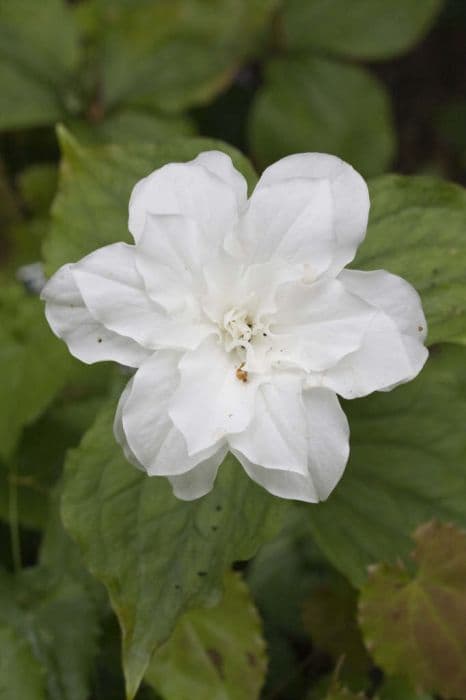Giant wakerobin Trillium chloropetalum var. giganteum

ABOUT
The plant in question, commonly known as the giant wakerobin, is a striking perennial that is recognized for its showy appearance. It features a single, erect stem that bears three large, glossy leaves. These leaves are typically a deep green with a noticeably wavy or undulating edge, and they are arranged in a symmetrical whorl, giving the plant a poised and balanced look. The most eye-catching aspect of the giant wakerobin is its flower. The bloom is a large, three-petaled beauty that sits above the leaves on a separate stalk. The petals can be variable in color, ranging from deep purplish-brown to greenish-white, often with beautiful mottling or striking solid hues. The center of the flower is usually accented with a cluster of stamens and a single, prominent pistil, drawing the eye to the middle of the bloom. Underneath the foliage, the plant's roots form a rhizome that allows it to spread and colonize the area where it grows. As the seasons change, the aerial parts of the giant wakerobin die back, and the plant goes dormant, waiting for the right conditions to emerge once again. Overall, its appearance in the landscape is one of elegance and dramatic simplicity, making it a beloved choice for woodland gardens and shaded natural areas.
About this plant
 Names
NamesSynonyms
Giant Wakerobin, Large Wakerobin, Giant Trillium
Common names
Trillium giganteum, Trillium chloropetalum.
 Toxicity
ToxicityTo humans
Giant trillium is not commonly known to be toxic to humans. However, as with many plants, it is possible that some individuals could have a sensitivity or allergic reaction if they ingest parts of the plant or come into contact with its sap. This can vary from person to person and is generally not considered widely harmful. Major symptoms of plant poisoning, which might hypothetically occur with any plant ingestion, usually include gastrointestinal distress such as nausea, vomiting, or diarrhea. In the case of contact sensitivity, skin irritation or a rash might occur.
To pets
Giant trillium is not commonly known to be toxic to pets. The plant is generally not considered a threat to domestic animals such as dogs and cats. However, caution should always be exercised with pets and plants, as individual animals might have unique sensitivities or allergies. If a pet were to ingest a significant amount of the plant, they might experience mild gastrointestinal upset, which could include symptoms such as vomiting or diarrhea. If such symptoms occur, it is advisable to consult a veterinarian.
 Characteristics
CharacteristicsLife cycle
Perennials
Foliage type
Deciduous
Color of leaves
Green
Flower color
Varies
Height
1-3 feet (30-90 cm)
Spread
1-2 feet (30-60 cm)
Plant type
Herb
Hardiness zones
7
Native area
North America
Benefits
 General Benefits
General Benefits- Ecosystem Support: Trillium chloropetalum var. giganteum, commonly known as Giant Wakerobin, provides food and habitat for local wildlife, including pollinators such as bees and butterflies, and is a part of the woodland plant community.
- Ornamental Use: With its large, showy flowers and mottled foliage, Giant Wakerobin is prized for its aesthetic appeal, adding visual interest to shade gardens and woodland settings.
- Native Plant Landscaping: As a native plant, Giant Wakerobin requires fewer resources such as water and fertilizers than non-native species, once established, and supports local ecosystems.
- Seasonal Interest: Giant Wakerobin blooms in early spring, providing early-season color to gardens when many other plants have not yet started to grow or flower.
- Erosion Control: The plant's root system helps stabilize soil, especially in shaded woodland areas where it naturally thrives, reducing erosion along slopes and banks.
- Heritage Preservation: As a native plant, cultivating Giant Wakerobin helps to preserve the botanical heritage and biodiversity of the regions where it naturally occurs.
 Medical Properties
Medical PropertiesThis plant is not used for medical purposes.
 Air-purifying Qualities
Air-purifying QualitiesThis plant is not specifically known for air purifying qualities.
 Other Uses
Other Uses- Garden Aesthetics: Giant wakerobin is often used in shade gardens and woodland settings for its striking three-petal flowers and large leaves, adding an aesthetic appeal to the landscape.
- Natural Dye: The petals and roots of the giant wakerobin can be used to produce natural dyes, although this is not a common use, it can yield various shades depending on the mordant used.
- Educational Tool: Botany students and enthusiasts may study the giant wakerobin for its interesting reproductive strategies, including its reliance on myrmecochory, the dispersal of seeds by ants.
- Photography Subject: The distinct appearance of the giant wakerobin makes it a popular subject for nature photographers and plant enthusiasts, contributing to biodiversity awareness.
- Cultural Symbolism: In some cultures or regions, the giant wakerobin may be considered a symbol of the onset of spring and is sometimes used in spring festivals and celebrations.
- Indicator Species: Giant wakerobin can serve as an indicator species, as its presence can suggest a well-preserved, undisturbed ecosystem, particularly in forested areas.
- Companion Planting: Enthusiasts of native plants may use giant wakerobin in companion planting to create a more naturalized, symbiotic garden environment that supports local wildlife.
- Crafts and Decor: The distinctive leaves and flowers of the giant wakerobin can be used in crafts or as organic decor in various art projects, although this is a rare and niche use.
- Floral Arrangements: While not commonly used in floristry, the giant wakerobin can be included in wildflower arrangements for a unique and dramatic effect.
- Garden Biodiversity: Planting giant wakerobin can increase the biodiversity of a garden, supporting a wider range of insect life, including pollinators like bees and butterflies.
Interesting Facts
 Feng Shui
Feng ShuiThe Giant wakerobin is not used in Feng Shui practice.
 Plant Symbolism
Plant Symbolism- Beauty: Trillium chloropetalum var. giganteum, commonly known as Giant Wake Robin, is often associated with beauty due to its elegant flower structure and vibrant colors.
- Purity: The trinity of petals that the Giant Wake Robin exhibits symbolizes purity and is often connected to the Virgin Mary in Christian symbolism.
- Elegance: With its sophisticated three-petal configuration the Giant Wake Robin represents grace and sophistication in the plant world.
- Rebirth: As a perennial that emerges in the spring, Giant Wake Robin signifies renewal and the beginning of a new cycle of growth.
- Healing: Historically, some trillium species have been used in medicinal remedies which lends the Giant Wake Robin the symbolic meaning of healing and recovery.
 Water
WaterFor the Giant Wake Robin, it’s essential to maintain evenly moist soil, especially during its growing season in spring and early summer. Water the plant once a week with about 1 gallon of water, ensuring that the water penetrates deeply into the soil. During the dormant period, in late summer and fall, reduce watering frequency as the plant requires less moisture. Adjust the watering schedule depending on the rainfall and check the soil moisture before watering to avoid overhydration.
 Light
LightThe Giant Wake Robin thrives in partial to full shade, making it ideal for woodland gardens or shaded areas beneath trees. It should be protected from intense, direct sunlight, which could scorch the leaves and impair growth. The best spot for this plant is one where it can receive dappled sunlight or light shade throughout the day.
 Temperature
TemperatureThe Giant Wake Robin prefers a temperate climate and is hardy in a range of temperatures, typically from 60 to 75 degrees Fahrenheit. It can survive minimum temperatures down to about 20 degrees Fahrenheit but may struggle if temperatures drop below that threshold. The ideal conditions mimic its natural woodland habitat, avoiding extremes of heat and cold.
 Pruning
PruningPruning the Giant Wake Robin is generally unnecessary, as it's a low-maintenance plant. If you need to remove damaged or dead foliage, do so after flowering has completed, typically in late spring or early summer. Avoid excessive pruning as this can disturb the natural growth cycle of the plant.
 Cleaning
CleaningAs needed
 Soil
SoilGiant Trillium (Trillium chloropetalum var. giganteum) thrives in rich, well-drained soil with a high content of organic matter, such as a mixture of loam, peat moss, and well-rotted leaf mold. The soil pH should be slightly acidic to neutral, ideally between 5.5 and 7.0.
 Repotting
RepottingGiant Trillium should be repotted every 2 to 3 years to refresh the soil and to accommodate the growth of its rhizomes. It's best to repot the plant after flowering, usually in late spring or early summer.
 Humidity & Misting
Humidity & MistingGiant Trillium prefers a moderately humid environment, mimicking its native woodland habitat, where there is high natural humidity, especially during their growing season.
 Suitable locations
Suitable locationsIndoor
Provide shade, cool temps, and moisture.
Outdoor
Partial shade, moist, well-drained soil, mulch.
Hardiness zone
5-9 USDA
 Life cycle
Life cycleGiant wakerobin begins its life cycle as a seed, which, upon germination, grows a primary rhizome. The plant then enters a juvenile vegetative stage where a solitary leaf emerges annually; during this stage, it gradually develops a more complex rhizome system. Over several years, the plant matures and reaches the adult stage, characterized by the production of three mottled leaves and a single, large, three-petaled flower, typically deep maroon or greenish-white in color. After pollination by insects, the flower develops into a berry-like fruit containing seeds, which can be dispersed by wildlife or gravity. Once the fruiting process is complete, the foliage dies back, and the plant enters a period of dormancy during the colder months. The rhizome survives underground where it stores energy to support the next year's growth, thus continuing the perennial cycle.
 Propogation
PropogationPropogation time
Spring
The Giant Wakerobin, known botanically as Trillium chloropetalum var. giganteum, can be propagated primarily through division. The best time for this method is in late summer to early fall, after the plant has flowered and the leaves have begun to die back. During this period, the plant is dormant, minimizing stress and making it safer to handle the roots. To propagate by division, carefully dig up the entire plant, making sure to keep as much of the root system intact as possible. Once the plant is out of the ground, gently separate the rhizomes, ensuring each division has at least one growth bud. Replant the divisions at the same depth they were growing at originally, and space them about 18 inches (45.72 centimeters) apart to give each new plant enough room to grow. It's essential to water the newly planted divisions well and keep the soil moist to encourage root development.
